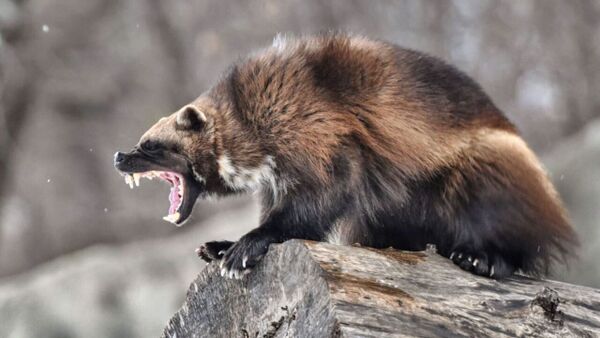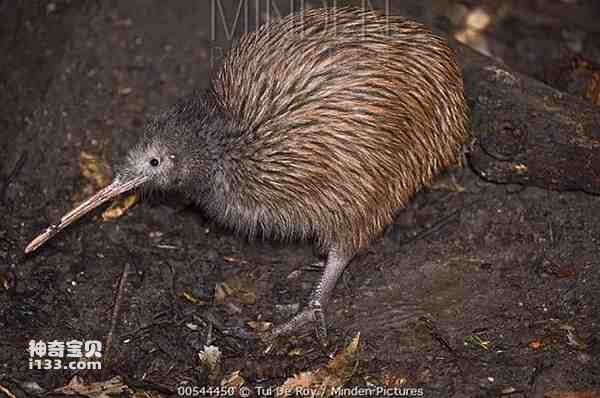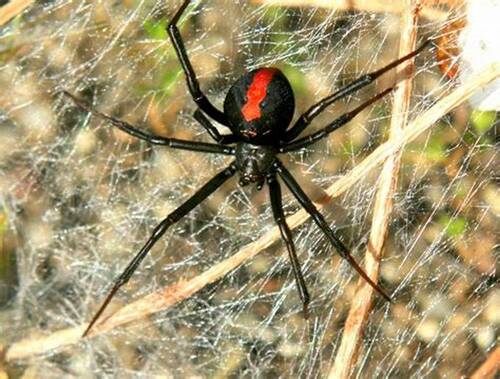The wolverine (scientific name: Gulo gulo), also known as the bully or North American flat-headed brother, is A large member of the mustelid family, wolverines are known for their toughness and ability to survive. Despite their small size, wolverines are extremely aggressive and can fight prey much larger than themselves. Found in cold regions of North America, Europe, and Asia, wolverines have adapted to their harsh environments and are impressive predators.

1. Characteristics of WolverinesBody shape: Wolverines are relatively stout, weighing about 10-25 kg and 60- 100 cm. Despite their small size, they are sturdy and have strong bones.
Appearance: Wolverines are similar in appearance to small bears, with short, thick limbs. , broad head, and dense brown-black fur. They have light-colored stripes on their backs, and their fur is thick and oily to protect against cold weather.
Teeth and Claws: Wolverines have extremely sharp teeth and claws, specially adapted for tearing through the flesh and bones of their prey. They are able to easily crush heavy bones, making them efficient scavengers.
Sense of Smell: Wolverines have a highly developed sense of smell, allowing them to sniff out hidden prey even when snow is covering their bodies.
2. Wolverine Reproduction
Mating Season: The mating season for wolverines is usually between May and August in the summer. Female wolverines give birth to cubs every two to three years.
Delayed implantation: Wolverines have a unique reproductive strategy called delayed implantation. The fertilized egg can be delayed for several months before implanting into the uterine wall, ensuring the birth of the cub. Born in the most favorable season (late winter or early spring).
Pregnancy and cubs: The gestation period of wolverines is about 30-50 days. Each litter usually contains 1 to 3 pups. The cubs are born light and dependent on their mother for care. Over the next few months, the mother wolverine will raise the cubs until they are able to forage for food independently.
3. Habits of wolverines
Solitary: Wolverines are solitary animals and only breed when they are They only interact with other individuals in different seasons. They have a very strong sense of territory. Usually a wolverine's activity range covers hundreds of square kilometers, marking its territory to warn other individuals.
Diet: Wolverines are omnivores, and although they prefer meat, they also eat plants. They prey mainly on small mammals, birds, and insects, but they also prey on larger prey such as reindeer and elk. In addition, they are scavengers, using their sense of smell to find remaining animal carcasses, especially in winter, when wolverines can bite through the thick snow to find food.
Strong fighting ability: Despite their small size, wolverines are known for their extremely strong character. They will not hesitate to attack animals much larger than themselves, such as bears or wolves, and even drive these predators away to snatch their prey.
4. Distribution of wolverines
North America: Wolverines are mainly distributed in the northern part of North America, including Alaska, northern Canada, and some mountainous areas in the United States, such as the Rocky Mountains.
Europe and Asia: In Europe, wolverines are mainly distributed in Northern European countries such as Finland, Sweden, and Norway. There are also a large number of wolverines distributed in Siberia, Russia. They have adapted to these cold and harsh environments, especially in the taiga and tundra areas.
5. Other interesting facts
Other names: The wolverine's English name "Wolverine" comes from its strong character and ferocious hunting skills. They are sometimes called "bullies" or "North American flat-headed brothers", which highlight their character of not fearing strong enemies.
Rare species: Due to habitat destruction and interference from human activities, the number of wolverines has decreased in some areas, especially in parts of Europe and the United States. They are listed as endangered or threatened species, and protection measures are being gradually implemented.
Winter adaptability: Wolverines are very adaptable to cold climates. Their thick fur not only keeps them warm, but also protects them from cold winds and moisture. They are good at moving in the snow and can dig holes in the snow to live.
Conclusion
Wolverines are one of the most powerful predators on earth. Despite their small size, they have amazing strength, smart foraging skills and the ability to adapt to extreme environments. Their unique habits and strong survival ability make them an indispensable existence in nature.
As a species that is vital to the ecosystem, the survival and reproduction of wolverines in cold regions plays an important role in the healthy development of the natural environment. By understanding and protecting this mysterious animal, we can better maintain the ecological balance in these harsh environments.
The relationship and difference between wolverines and honey badgers
Although wolverines and honey badgers have similar names and are both known for their toughness and fearlessness of challenges, they have significant differences in biological classification, habitat, and behavioral habits. The following is a detailed description of their relationship and main differences. Introduction:
1. Biological classification
Wolverine (Gulo gulo) and honey badger (Mellivora capensis) both belong to the Carnivora, but differ in family and genus:
Wolverine It belongs to the Mustelidae family and is closely related to weasels, badgers, martens and other animals.
Honey badgers belong to the Mustelidae, Melinae subfamily, and are more closely related to other badgers. Close.
Although they both belong to the family Mustelidae, they are not directly related and belong to different evolutionary branches.
2. Habitat and distribution
Wolverines mainly live in the cold Northern Hemisphere, and are distributed in Canada and Alaska in North America, the Nordic countries in Europe, and Siberia in Asia. These areas are usually coniferous forests, tundra, and mountainous environments. , the climate is cold and the environment is harsh.
Honey badgers are found in warmer regions of Africa and South Asia, especially in the Sahara. Most of Africa south of the Yellow Sea, as well as grasslands, forests and deserts in India, Pakistan and Iran.
3. Size and appearance
Wolverines are large in size, usually weighing between 10-25 kg, with a relatively sturdy body, and look like a small bear, with dense fur. It is dark brown or black with light stripes on its back.
The honey badger is relatively small, usually weighing between 7-14 kg. between. The honey badger has a more slender appearance, with a distinctive black and white fur on its back, and a white stripe extending from the top of the head to the tail.
4. Personality and behavior habitsWolverines are mostly solitary, fierce and aggressive, especially When competing for food. They are scavengers, often using their sense of smell to find dead animals, and dare to fight against predators larger than themselves, such as bears or wolves, and even dare to snatch their prey.
Honey badgers are known for their aggression and fearlessness. They are very brave and often fight dangerous animals such as lions and poisonous snakes. Combat. The honey badger's skin is very thick and loose, which allows it to easily turn around and fight back when attacked. At the same time, they can withstand the venom of venomous snakes and have amazing recovery ability.
5. Diet and predation methods
Wolverines are omnivorous, but they prefer to be carnivorous. They prey on small mammals such as rabbits and rodents, and occasionally capture large animals such as reindeer and elk, and can even gnaw on animal bones. Their teeth and jaws are very strong and can easily tear through tough pieces of meat and bones.
Honey badgers have a diversity of food, including insects, amphibians, small mammals, birds, etc., and are particularly good at preying on venomous snakes. At the same time, honey badgers love honey very much and will even enter beehives to steal honey, which is also the origin of their name. They also cooperate with honey guides, with birds guiding honey badgers to find beehives, and honey badgers destroy the beehives and share the food.
6. Reproduction and living habits
The reproductive characteristics of wolverines include delayed implantation, that is, the fertilized egg will be delayed for a period of time before implanting in the uterus to ensure that the cubs are born in the right season (usually in late winter or early spring).
The reproductive cycle of honey badgers is relatively ordinary. Female honey badgers usually give birth to 1-2 cubs each time. The cubs live with their mothers and rely on their mothers for prey and protection until they can live independently.
7. Defense and Survival
Wolverines are very aggressive when facing predators, and with their strong bodies and tough fur, they can effectively defend and attack. They often choose to fight with predators, especially when snatching food.
Honey badgers can flexibly respond to enemy attacks due to their thick, loose skin. In addition, they can withstand extreme venom and have extremely fast healing ability. Even if they are bitten by venomous snakes, they can recover in a short time.
Summary: The relationship and difference between wolverines and honey badgers
Although wolverines and honey badgers belong to the family Mustelidae of the order Carnivora and are both known for their bravery and aggressiveness, their habitats, body shapes, appearances, diets, and living habits are significantly different. Wolverines mainly live in the cold northern hemisphere, feeding on scavengers and hunting, while honey badgers live in warm areas of Africa and South Asia, and are known for catching snakes and eating honey. Wolverines focus more on strength and fighting skills, while honey badgers rely on the defensive ability of their skin and their courageous character to survive.
Both have demonstrated strong adaptability and tenacious survival instincts, becoming unique and powerful beings in their respective habitats.
Distribution and number of wolverines in various countries
The following is a table showing the distribution and approximate number of wolverines in various countries:
| Country/Region | Distribution Area | Approximate number (estimated) | Conservation status |
|---|
| Canada | Alaska border, Yukon, northern Canada | About 15,000-20,000 | The number is relatively stable |
| United States | Alaska, Rocky Mountains and other areas | About 250-300 (Rocky Mountains area) | Endangered/threatened species |
| Russia | Siberia, Ural Mountains | About 20,000-30,000 | Stable population |
| Finland | Northern forests and tundra | About 150-200 | Rare/protected species |
| Sweden | Forests in the northern and central regions | About 500-600 | Protected species |
| Norway | Northern regions | About 300-400 | Protected species |
| Estonia | Forest and swamp areas | About 100-200 | Rarely found |
| Latvia | Northern forest zone | About 100-150 | Rare |
| Poland | Northeastern forest zone | Very small number | Endangered |
| Mongolia | Altai Mountains | Unknown | Rare |
| Kazakhstan | Northern mountainous areas, forest areas | Unknown | Rare |
Note:
Number estimate: Due to the wide range of activities and strong secretiveness of wolverines, the number of wolverines in various places is difficult to accurately count, and the above data is an estimate.
Conservation status: The conservation status of wolverines varies in different regions. Some regions in North America and Northern Europe list them as endangered or threatened species and implement corresponding protection measures.
Which country uses wolverines as food
Wolverines are not widely used as food, mainly because their meat is rough and has a strong body odor, making it difficult to cook. In addition, wolverines are a legally protected species in many areas, so hunting and eating them is illegal. However, in some remote areas, especially Indigenous peoples near the Arctic Circle or nomadic peoples in extremely cold areas, wolverines may be hunted to satisfy hunger when food resources are extremely scarce.
Situations where wolverines are primarily consumed:
North American Natives (such as the Inuit):
In extreme climates, the Inuit and other Arctic natives sometimes hunt wolverines. Wolverine meat is used as a survival option in these situations, especially during the winter when food supplies are low.
However, this practice is rare, as wolverine meat is not considered a high-quality food, and their fur may be used to make cold-weather clothing.
Minorities in Siberia:
In some remote areas of Siberia, Russia, such as the Yakuts or Chukchi, wolverines are occasionally hunted for food, especially during the long, cold winters.
However, wolverine meat is not a primary food source in these cultures, but rather an emergency or survival option.
In general, the consumption of wolverines is very rare, and wolverines are seen more as a mysterious and powerful animal than a common food source.
animal tags:
Wolverine
We created this article in conjunction with AI technology, then made sure it was fact-checked and edited by a Animals Top editor.









